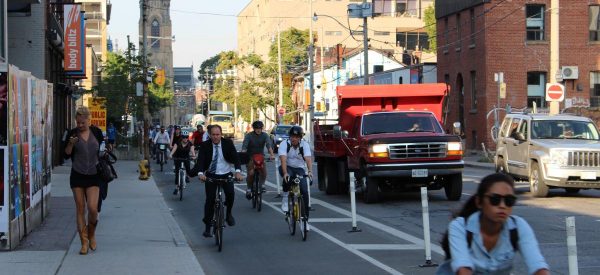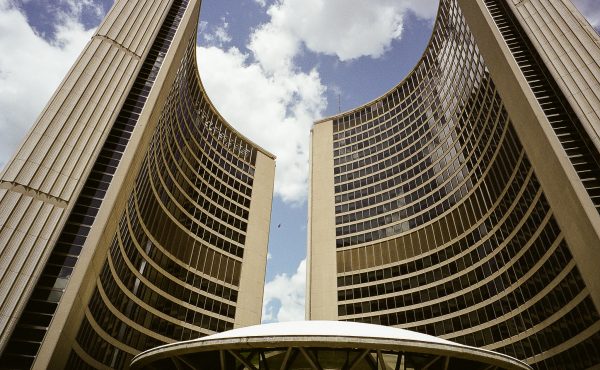A cross-post from Cycle Toronto
Since 2014, we’ve been calling on City Council to build a city-wide Minimum Grid of 100km of protected bike lanes and 100km of bicycle boulevards by 2018. Toronto is proposing a new 10-year cycling network plan that would add 280km of bike lanes or cycle tracks, 55km of boulevard trails and 190km of quiet streets. Major corridors identified include Bloor, Danforth, Yonge downtown, Lakeshore, Jane, Midland, Kingston Rd., among others in the suburbs. City staff have provided five options for funding the new bike plan and have recommended the $16 million option that would see 85% of the plan built out in 10 years. The City would look to the province and feds to fund the remaining 15%.
We’re thrilled that the number of proposed kilometres exceeds our original ask but the $16 million option doesn’t build the network soon enough. City staff have also reported on $20 million and $25 million options. The $20 million option would build 100% of the plan in eight to nine years and the $25 million option would build 100% of it in six to seven years. We think City Council should boost the budget to $25 million and here’s why….
Top 5 reasons to invest $25 million and build the Bike Plan as soon as possible
1. Get the city moving
Up to 55% of all trips that Torontonians make are less than 7 km in length, which can typically be travelled by bicycle in 30 minutes or less. Toronto will welcome 1 million new residents over the next 25 years and we need more efficient ways to move. Rapid roll out of cycling infrastructure will not only make Toronto streets safe for all but is a way to fight congestion and get Toronto moving.
2. Torontonians need safe streets now
Toronto is a city of cyclists. Over the last year, 1.5 million Torontonians have ridden a bicycle. And they want to ride more often. 73% of Torontonians say a lack of cycling infrastructure is holding them back from riding more often. We can see why. The implementation of safe, cycling infrastructure has been slow with minimal investment in on-street cycling routes outside of the core over the last 7 years. What’s more, a cyclist is hit by a car driver every 6 hours of every day of the year. The new bike plan is a critical way to make streets safe for all.
3. If you build it, they will come
Toronto built the Richmond Adelaide cycle tracks which closed a major gap in the cycling network downtown. 1 year after implementation, the number of riders on Adelaide tripled. Queen’s Quay is another significant success story. The summer after the opening of the new bike path along Queen’s Quay, a 24-hour cyclist count found it moving more than 6,000 people by bicycles. Cycling infrastructure can be rolled out rapidly and get Toronto moving.
4. Toronto is a world class city and has fallen behind
New York, Montreal, Vancouver, Paris and London are all making significant investments to build their cycling networks. Seville, Spain — a city of 700,000 people — grew mode share from 0.5% to 7% of trips in six years and they did this by installing a backbone network of nearly 130 km of protected lanes throughout the city and a broad roll out of their bike sharing system.
5. We can afford it
Toronto’s 2016 capital budget is roughly $3 billion. That’s 3,000 million dollars. 25 million dollars is a fraction of this amount. Toronto is spending roughly $745 million on the Scarborough Subway, $526 million on the Toronto York Spadina Subway Extension and $505 million on reconstructing the Gardiner. Cycling infrastructure is an inexpensive way to get Toronto moving now.
The roll out of our on-street cycling network has moved at a glacial pace for years. With a small investment we can make a big impact and get Toronto moving.





2 comments
Riding a bike in Toronto is dangerous. I doubt if bike lanes make any significant difference. Look at the number of accidents on College Street and other roads with bike lanes in the report on pedestrian and cyclist safety that Toronto Public Health did last year.
Andrew, uninformed, speculative opinions are not helpful. In this case, yours goes against all evidence about cycling networks gathered in hundreds of cities, and will assist in maintaining the unacceptable status quo.